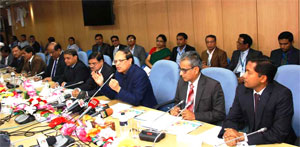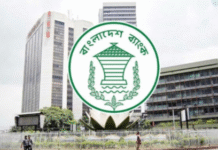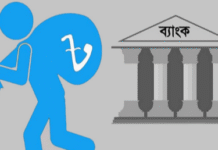Bangladesh Bank governor Dr Atiur Rahman has announced an “investment stimulating monetary policy” for January-June period of the fiscal 2015-16 with a target of 14.8 percent private sector credit growth and 18 percent public sector investment growth to spur the country’s economy now suffering from growing stagnation.
Making the policy announcement the central bank governor said he has recalibrated the central bank lending and buying rates from commercial banks to make more money available in the hands of banks for more and bigger credit for investment.. In keeping with the new policy he is also asking banks to reduce the lending rates so that investors may come forward to make fresh investment ignoring risks.
The governor said growth has been projected at 6.8 to 6.9 percent during the current fiscal and it may even reach 7 percent if things go well. The governor said so far the country’s monetary and fiscal policy was aimed at boosting the ‘engine of export’ but simultaneous emphasis would go now to boosting the engine of accelerating domestic demand to bring prosperity to the nation.
The governor said the country is enjoying relative political stability at the moment over the recent chaos and believes that cheaper cost of capital may bring spur to investment. It is however his formal calculation and experts hold the view that much of the success of the new monetary would depend on how business and other players in the economy would study the situation and calculate new investment plans.
The new policy has recalibrated repo and reverse repo rate by 0.5 percent accordingly. Under the repo rate central bank sells money to banks to beef up capital base and under the reduced rate banks can more borrow from central banks at 6.75 percent now up from 7.25 percent previously.
The reverse repo which allows a bank to deposit its excess fund with the central bank, has on the other hand reduced the rate from 6.25 to 4.75 suggesting that a bank will get less by depositing excess fund to central bank and therefore would be encouraged to put money to new investment at lower interest.
Meanwhile, the private sector credit growth target in the first half of the current fiscal from July to December fell short of the 15 percent target and was achieved at 13.72 percent as of November last. So the central bank has fixed the target of the second half at slightly below the first half’s target but sufficiently above the performance in the first half’s.
The governor has however made it clear that global growth potentials have slowed down and global growth performance will also be slower than in the past. So Bangladesh should be ready to work harder to achieve the same level of growth.
Dr Atiur Rahman has unveiled the latest monetary stance terming it as a ‘cautious but supportive’ move to achieve higher growth. “As always, we remain vigilant and ready to adjust our stance as facts on the ground and the outlook on the horizon evolve.”
Since the last July-December policy, he said prices have remained broadly stable with average inflation moderating from 6.4 percent in June to 6.2 percent in December and currently within the target.
But December’s core inflation — without food and fuel — of 6.8 percent reflects some price pressure and, therefore, suggests a need for caution, he said.
The new policy projected that inflation will be 6.1 percent in June, which is lower than the government’s budgetary target of 6.2 percent.
Inflation during the last six month hovers around 6.8 to 6.9 percent, which is slightly less than the government’s target of 7 percent. Bangladesh’s projected GDP growth for 2016 will be almost double the world GDP growth and even higher than China’s for the first time. “What does it mean for our macro-strategy and growth aspirations? The short answer is: for the same level of growth, we will need to row harder.”
But providing gas, electricity and infrastructure to businesses should be priorities. These are the factors retarding the growth.
Commenting on the new monetary policy Prof Mustafizur Rahman, executive director of the Centre for Policy Dialogue (CPD) said, “Interest cuts is just a signal and do not guarantee a reduction in bank interest rates. The benefits of the rate cut will depend on how the transmission mechanism works. He also said factors like business environment and cost of doing business would be critical to gain from the move.
Ahsan H Mansur, executive director of the Policy Research Institute (PRI), said policy rate cuts would give a stimulus that would let people borrow more at cheaper costs. But he is not sure whether the move will ensure a lower lending rate.
He said the central bank is needed to work hard on the spread or the gap between lending and deposit rates. “If we minus the spread of state banks, the banking industry’s average spread will be six percent plus, which is in no way acceptable,” Mansur said.
Many fear that the new monetary policy has its limitation to influence things within the available macroeconomic periphery. But Bangladesh needs huge annual investment to bring spur to the domestic economy and only slight variations ion interest rates is not enough to do it.
According to Bangladesh Foreign Investors Chamber of Commerce and Industry (BFICCI) Rupali Chowdhury, Bangladesh needs at least $10 billion Foreign Direct Investment (FDI) to spur the economic growth to the level of its growth potentials. Much of its potential is unutilized now and to achieve that it appears that the new monetary policy stands out to be a small attempt.
The crisis is political instability marred with high level of corruption, lack of capacity of the government institutions and inefficiency of leadership to handle business issues and economic development.
Bangladesh Bank has over $27 billion foreign currency reserves but the new monetary policy lacks direction as to how to utilize it to accelerate the nation’s socio-economic development.
The country has also over $22 billion development assistance in the pipeline and inefficient political leadership and an inept bureaucracy are what people hold responsible for failing to use it in time.
The central bank has stressed on quality credit disbursement over higher credit growth.
To activate banks in utilising idle liquidity in productive lending to farm and non-farm enterprises, the area heads of BB offices have been advised to engage in field visits with bankers in search for eligible clients still out of financial inclusion initiatives.
To further expand the existing clientele, the BB has also advised all banks to send their officials to explore new lending opportunities that had not been cultivated yet.
“These initiatives will hopefully create more productive credit demand and new employment opportunities in the economy,” the MPS said.
Commercial banks have been motivated and supported in extending loans to the productive and vulnerable sectors at lower interest rates. Green projects will get loans at a lower rate and so will export promotion activities.
The World Bank has committed to contribute $300 million as credit, which will be used for medium to longer term foreign currency financing of manufacturing projects at low costs.
The BB will add another $200 million for green initiatives in the export-oriented textile, apparel and leather sectors.
Thus, the BB has adopted selective easing through judicious variations of interest rates, according to the MPS.
If taken together, the productive sectors are accessing low-cost financing and hence contributing substantially to the supply-side capacity of the economy, it added.
Only policy interest rate cuts are not enough to boost investment, as there are other factors such as business environment, investment certainty and cost of doing business, which analysts say need to be addressed for a higher growth.
However, they hope that the sluggish investment situation prevailing for the past few years will improve if the cost of bank loan comes down after the key policy rate cut.
Bangladesh Bank yesterday lowered the key policy rate or repo and reverse repo by 0.5 percent to 6.75 percent and 4.75 percent respectively.
Repo rate, at which the BB lends to commercial banks and reverse repo rate at which the BB mops up money from banks, came down for the first time in over three years.
The analysts, however, point out that the central bank could have been a little more ambitious in lowering the inflation target below six percent given the falling commodity prices on the global market.
“This rate cut is just a signal and do not guarantee a reduction in bank interest rates,” said Prof Mustafizur Rahman, executive director of the Centre for Policy Dialogue (CPD).
The benefits of the rate cut will depend on how the transmission mechanism works, he said.
He also said factors like business environment and cost of doing business would be critical to gain from the move.
Ahsan H Mansur, executive director of the Policy Research Institute (PRI), said policy rate cuts would give a stimulus that would let people borrow more at cheaper costs.
But he is not sure whether the move will ensure a lower lending rate.
He said the BB needed to work hard on the spread or the gap between lending and deposit rates.
“If we minus the spread of state banks, the banking industry’s average spread will be six percent plus, which is in no way acceptable,” said Mansur, also a former top official of the International Monetary Fund.
The BB announced its monetary policy stance (MPS) for January-June period yesterday. It has lowered the broad money and private sector credit growth targets to 15 percent and 14.8 percent accordingly. The MPS set a target of private sector credit growth for June at 14.8 percent, which was 15 percent in the previous MPS announced in July last.
The central bank said the target was slightly lower than that in the last, but higher than the actual outcome. In November, the private sector credit growth was 13.72 percent on year-on-year basis.
The MPS has set gross domestic product (GDP) growth target at 6.8 to 6.9 percent. Inflation has been projected at 6.1 percent for June this year, slightly down from 6.2 percent in November.
Dr Mustafa K Mujeri, former director general of Bangladesh Institute of Development Studies (BIDS), termed the new monetary policy as usual and said it would not guarantee an investment boost.
“Policy rate cuts are just an indication and it cannot ensure higher investments as there are other factors, such as investment climate and infrastructure constraints,” said Mujeri, also a former chief economist at the BB.
“We need a quantum jump in investments, but there is no clear message about it in the MPS,” he said.
He also said the BB could have reduced the inflation target below six percent given the global and regional inflation rates.
Zahid Hussain, lead economist at the World Bank’s Dhaka office, said the revised stance on policy rates sent a signal to bankers to expand private credit by reducing lending rates.
To avoid the adverse impact on the profits of the BB, this was an opportune time to reduce the reverse repo rate and correspondingly the repo rate, he noted.
However, though there is not much in this than just the signaling aspect, these reductions signal banks to be more proactive in finding bankable projects and to lend in the private sector.
“Even if banks do not pass on the lower interest rates onto customers, they will be able to borrow more which they can pump into the system,” he said.
Zaid Bakht, an economist and chairman of Agrani Bank, believed the policy rate cuts would have a positive impact on the commercial lending rates as banks’ cost of funds will go down.
“It [rate cut] will be helpful to boost private investments,” he said.
Anis A Khan, managing director of Mutual Trust Bank and chairman of Association of Bankers, Bangladesh (ABB), said that the already declining lending rates would decrease further.
“The rate cuts signal to the market to increase investment activities,” he said.
Khan also hailed the new MPS, saying that it reflected the country’s strong macro-economic fundamentals.
Source: Weekly Holiday










